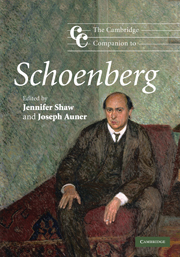Book contents
- Frontmatter
- 1 Introduction
- Part I Schoenberg's early years
- Part II Schoenberg, modernism, and modernity
- Part III Schoenberg between the World Wars
- Part IV Schoenberg's American years
- 15 Cadence after thirty-three years: Schoenberg's Second Chamber Symphony, Op. 38
- 16 Schoenberg's collaborations
- 17 Listening to Schoenberg's Piano Concerto
- 18 Schoenberg reception in America, 1933–51
- 19 Schoenberg: dead or alive? His reception among the postwar European avant-garde
- Notes
- Select bibliography
- Index
17 - Listening to Schoenberg's Piano Concerto
from Part IV - Schoenberg's American years
Published online by Cambridge University Press: 28 September 2011
- Frontmatter
- 1 Introduction
- Part I Schoenberg's early years
- Part II Schoenberg, modernism, and modernity
- Part III Schoenberg between the World Wars
- Part IV Schoenberg's American years
- 15 Cadence after thirty-three years: Schoenberg's Second Chamber Symphony, Op. 38
- 16 Schoenberg's collaborations
- 17 Listening to Schoenberg's Piano Concerto
- 18 Schoenberg reception in America, 1933–51
- 19 Schoenberg: dead or alive? His reception among the postwar European avant-garde
- Notes
- Select bibliography
- Index
Summary
Behind the words of Schoenberg's 1946 essay “Heart and Brain in Music,” one can hear the aging composer railing against those who had branded him as a heartless intellectual. This particular criticism stung him acutely, even though he believed that it reflected more on the naivety of his critics than on a realistic interpretation of his works. For Schoenberg, “heart” and “brain” could not be separated in the compositional process, nor did he believe that the great composers of the past had considered them separately. While purporting to address the relative importance of inspiration and conscious construction in all manner of music, Schoenberg obviously sought to demonstrate in this essay that the perceived complexity of his own music – and especially that of his twelve-tone works – was congruent with long-standing musical traditions that valued the cerebral and the emotive equally.
To illustrate his thesis, Schoenberg cited musical examples in which passages produced via inspiration were difficult to differentiate from those resulting from extensive conscious effort. For example, as an illustration of a melody that listeners would most likely identify as emotive and “inspired,” Schoenberg provocatively cited the beginning of his Concerto for Piano and Orchestra, Op. 42, written four years earlier (1942). The irony, as Schoenberg undoubtedly intended, was that this conventionally lyrical theme occurred in a twelve-tone work (Example 17.1). The existence of such a theme, he implied, proved that the twelve-tone method, which had earned him “the title of constructionist, engineer, mathematician, etc., meaning that these compositions are produced exclusively by the brain without the slightest participation of something like a human heart,” was far from “heartless.”
- Type
- Chapter
- Information
- The Cambridge Companion to Schoenberg , pp. 238 - 246Publisher: Cambridge University PressPrint publication year: 2010
- 2
- Cited by



